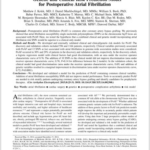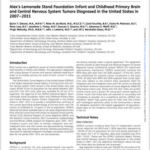Kolek MJ, Muehlschlegel JD, Bush WS, Parvez B, Murray KT, Stein CM, Shoemaker MB, Blair MA, Kor KC, Roden DM, Donahue BS, Fox AA, Shernan SK, Collard CD, Body SC, Darbar D,. Postoperative atrial fibrillation (PoAF) is common after coronary artery bypass grafting. We previously showed that atrial fibrillation susceptibility single nucleotide polymorphisms (SNPs) at […]
Tag Archives: United States
Genetic and clinical risk prediction model for postoperative atrial fibrillation.
Postoperative atrial fibrillation (PoAF) is common after coronary artery bypass grafting. We previously showed that atrial fibrillation susceptibility single nucleotide polymorphisms (SNPs) at the chromosome 4q25 locus are associated with PoAF. Here, we tested the hypothesis that a combined clinical and genetic model incorporating atrial fibrillation risk SNPs would be superior to a clinical-only model.We […]
Alex’s Lemonade Stand Foundation Infant and Childhood Primary Brain and Central Nervous System Tumors Diagnosed in the United States in 2007-2011.
Ostrom QT, de Blank PM, Kruchko C, Petersen CM, Liao P, Finlay JL, Stearns DS, Wolff JE, Wolinsky Y, Letterio JJ, Barnholtz-Sloan JS,. The CBTRUS Statistical Report: Alex’s Lemonade Stand Foundation Infant and Childhood Primary Brain and Central Nervous System Tumors Diagnosed in the United States in 2007–2011 comprehensively describes the current population-based incidence of […]
Alex’s Lemonade Stand Foundation Infant and Childhood Primary Brain and Central Nervous System Tumors Diagnosed in the United States in 2007-2011.
The CBTRUS Statistical Report: Alex’s Lemonade Stand Foundation Infant and Childhood Primary Brain and Central Nervous System Tumors Diagnosed in the United States in 2007–2011 comprehensively describes the current population-based incidence of primary malignant and non-malignant brain and CNS tumors in children ages 0–14 years, collected and reported by central cancer registries covering approximately 99.8% […]
Mind the gap: resources required to receive, process and interpret research-returned whole genome data.
Most genotype-phenotype studies have historically lacked population diversity, impacting the generalizability of findings and thereby limiting the ability to equitably implement precision medicine. This well-documented problem has generated much interest in the ascertainment of new cohorts with an emphasis on multiple dimensions of diversity, including race/ethnicity, gender, age, socioeconomic status, disability, and geography. The most […]
Mind the gap: resources required to receive, process and interpret research-returned whole genome data.
Most genotype-phenotype studies have historically lacked population diversity, impacting the generalizability of findings and thereby limiting the ability to equitably implement precision medicine. This well-documented problem has generated much interest in the ascertainment of new cohorts with an emphasis on multiple dimensions of diversity, including race/ethnicity, gender, age, socioeconomic status, disability, and geography. The most […]
Mind the gap: resources required to receive, process and interpret research-returned whole genome data.
Most genotype-phenotype studies have historically lacked population diversity, impacting the generalizability of findings and thereby limiting the ability to equitably implement precision medicine. This well-documented problem has generated much interest in the ascertainment of new cohorts with an emphasis on multiple dimensions of diversity, including race/ethnicity, gender, age, socioeconomic status, disability, and geography. The most […]







